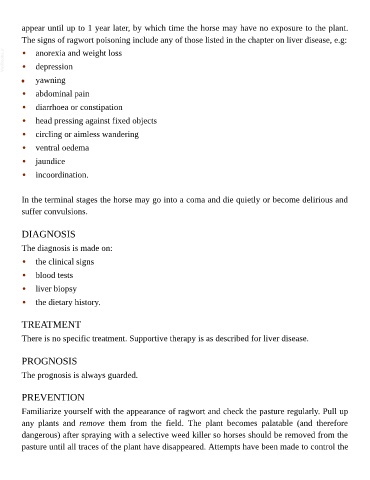Page 805 - The Veterinary Care of the Horse
P. 805
appear until up to 1 year later, by which time the horse may have no exposure to the plant.
The signs of ragwort poisoning include any of those listed in the chapter on liver disease, e.g:
VetBooks.ir • anorexia and weight loss
•
depression
• yawning
• abdominal pain
• diarrhoea or constipation
• head pressing against fixed objects
• circling or aimless wandering
• ventral oedema
• jaundice
• incoordination.
In the terminal stages the horse may go into a coma and die quietly or become delirious and
suffer convulsions.
DIAGNOSIS
The diagnosis is made on:
• the clinical signs
• blood tests
• liver biopsy
• the dietary history.
TREATMENT
There is no specific treatment. Supportive therapy is as described for liver disease.
PROGNOSIS
The prognosis is always guarded.
PREVENTION
Familiarize yourself with the appearance of ragwort and check the pasture regularly. Pull up
any plants and remove them from the field. The plant becomes palatable (and therefore
dangerous) after spraying with a selective weed killer so horses should be removed from the
pasture until all traces of the plant have disappeared. Attempts have been made to control the

